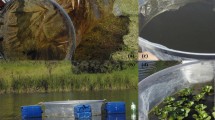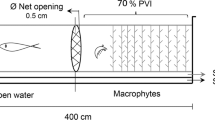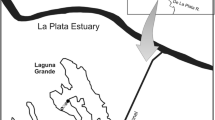Abstract
The resting stages of freshwater zooplankton constitute a special mechanism for passive dispersal, often displaying a variety of adaptations so as to ease transport. In floodplain systems, macrophytes are one of the most representative biotic groups showing interactions with the zooplankton community. The annual fluctuations in the hydrometric level of the Paraná River favour the displacement of this aquatic vegetation in floodplain environments. This paper hypothesizes that the roots and submerged portions of different macrophytes contain zooplankton resting stages which are able to hatch when environmental conditions are favourable. In turn, this contributes to the dispersal of zooplankton by plants when they are displaced by the flood pulse. Six macrophyte species were sampled (Eichhornia crassipes, Azolla filiculoides, Limnobium spongia, Pistia stratiotes, Eichhornia azurea and Nymphoides indica) from lakes within the Paraná River floodplain. Roots and submerged portions of vegetation were stored (90 days) at 4 °C then incubated at 25 °C for 90 days. Hatchling emergence was recorded at 2-day intervals during this period. In total, 70 zooplankton taxa were recorded in all macrophyte samples; rotifers were the most representative group (69%) followed by cladocerans (28%) and copepods (3%). The roots and submerged parts of aquatic vegetation house viable zooplankton resting stages. This phenomenon allows the dispersal of resting stages and therefore colonization of new habitats during the displacement of macrophyte species.






Similar content being viewed by others
References
Alekseev VR (2002) Copepoda. In: Fernando CH (ed) A guide to tropical freshwater zooplankton. Backhugs Publishers, Leiden, pp 123–188
Battauz YS, José de Paggi SB, Paggi JC (2014) Passive zooplankton community in dry littoral sediment: reservoir of diversity and potential source of dispersal in a subtropical floodplain lake of the Middle Paraná River (Santa Fe, Argentina). Int Rev Hydrobiol 99:277–286
Battauz YS, José de Paggi SB, Paggi JC (2015) Endozoochory by an ilyophagous fish in the Paraná River floodplain: a window for zooplankton dispersal. Hydrobiologia 755 (1):161–171
Battistoni P (1995) Copepoda. In: Lopretto E, Tell G (eds) Ecosistemas de aguas continentales. Metodologías para su estudio. Ediciones Sur, La Plata, pp 953–971
Bohonak AJ, Jenkins DG (2003) Ecological and evolutionary significance of dispersal by freshwater invertebrates. Ecol Lett 6:783–796
Bonetto A (1986) The Paraná River system. In: Davies BR, Walker KF (eds) The ecology of river systems. Dr W. Junk Publishers, Dordrecht, pp 541–598
Brendonck L, De Meester L (2003) Egg banks in freshwater zooplankton: evolutionary and ecological archives in the sediment. Hydrobiologia 491:65–84
Burkart A (1957) Ojeada sinóptica sobre la vegetación del Delta del Río Paraná. Darwiniana 11:457–561
Burks RL, Mulderij G, Gross E, Jones I, Jacobsen L, Jeppesen E, Van Donk E (2006) Center stage: the crucial role of macrophytes in regulating trophic interactions in shallow lake wetlands. In: Robbink R, Beltman B, Verhoeven JTA, Whigham DF (eds) Wetlands: functioning, biodiversity conservation, and restoration. Springer, Heidelberg, pp 37–59
Cáceres CE (1998) Interspecific variation in the abundance, production and emergence of Daphnia diapausing eggs. Ecology 79:1699–1710
Carlton JT (1992) Dispersal of living organisms into aquatic ecosystems as mediated by aquaculture and fisheries activities. In: Rosenfield A, Mann R (eds) Dispersal of living organisms into aquatic ecosystems. Maryland Sea Grant Publication, College Park, pp 13–45
De Stasio BT (1989) The seed bank of a freshwater crustacean: copepodology for the plant ecologist. Ecology 70:1377–1389
Dudgeon D, Arthington AH, Gessner MO, Kawabata Z, Knowler DJ, Léveque C, Naiman RJ, Prieur-Richard AH, Soto D, Stiassny ML, Sullivan CA (2006) Freshwater biodiversity: importance, threats, status and conservation challenges. Biol Rev Camb Philos Soc 81:163–182
Duggan IC, Green JD, Shiel RJ (2002) Rotifer resting egg densities in lakes of different trophic state, and their assessment using emergence and egg counts. Arch Hydrobiol 153:409–420
Fernandez OA, Sutton DL, Lallana VH, Sabbatini MR, Irigoyen J (1990) Aquatic weed problems and management in South and Central America. In: Pieterse AH, Murphy KJ (eds) Aquatic weeds. The ecology and management of nuisance aquatic vegetation. Oxford Science Publications, New York, pp 406–425
Fryer G (1972) Observations on the ephippia of certain macrothricid cladocerans. Zool J Linn Soc 51:79–96
Garcíar-Roger E (2006) Análisis demográfico de bancos de huevos diapáusicos de rotíferos. Tesis Doctoral. Universitat de València. Facultat de Ciències Biològiques Institut Cavanilles de Biodiversitat i Biologia Evolutiva
García-Roger EM, Armengol X, Carmona MJ, Serra M (2008) Assessing rotifer diapausing egg bank diversity and abundance in brackish temporary environments: an ex situ sediment incubation approach. Fundam Appl Limnol 173:79–88
Gazulha V, Montú M, Motta-Marques DML, Bonecker CC (2011) Effects of natural banks of free-floating plants on zooplankton community in a shallow subtropical lake in southern Brazil. Braz Arch Biol Technol 54:74–754
Gonzáles AE (2007) Influencia de Utricularia foliosa sobre la diversidad zooplanctónica en las dimensiones longitudinal y temporal de la Quebrada Yahuarcaca (Amazonia colombiana). Trabajo de grado, Universidad Distrital Francisco José de Caldas, Bogotá, Colombia
Hagiwara A, Hino A (1989a) Effect of incubation and preservation on resting egg hatching and mixis in the derived clones of the rotifer Brachionus plicatilis. Hydrobiologia 186:415–421
Hagiwara A, Hino A (1989b) Effect of incubation and preservation on resting egg hatching and mixis in the derived clones of the rotifer Brachionus plicatilis. Hydrobiologia 186(187):415–421
Hairston NG Jr, Cáceres CA (1996) Distribution of crustacean diapause: micro and macroevolutionary pattern and process. Hydrobiologia 320:27–44
Hamilton S, Sippel S, Lewis WM, Saunders JJ (1990) Zooplankton abundance and evidence for its reduction by macrophyte mats in two Orinoco floodplain lakes. J Plankton Res 12:345–363
Hammer Ø, Harper DAT, Ryan PD (2001) PAST: paleontological statistics software package for education and data analysis. Palaeontologia. IOP PublishingWeb. http://palaeo-electronica.org/2001_1/past/past.pdf. Accessed 4 June 2016
Havel JE, Shurin JB (2004) Mechanisms, effects, and scales of dispersal in freshwater zooplankton. Limnol Oceanogr 49:1229–1238
Havel JE, Stelzleni-Schwent J (2000) Zooplankton community structure: the role of dispersal. Int Ver Theor Angew Limnol 27:3264–3268
Havel JE, Eisenbacher ME, Black AA (2000) Diversity of crustacean zooplankton in riparian wetlands: colonization and egg banks. Aquat Ecol 34:63–76
Inger D, Deluque J, Reyes S, Sierra T (2004) Composición de la comunidad de macroinvertebrados acuáticos asociados a las macrófitas de la Ciénaga del cerro San Antonio. VI Seminario Colombiano de Limnología, Montería
Jeppesen E, Søndergaard MA, Søndergaard MO, Christoffersen K (1998) The structuring role of submerged macrophytes in lakes. Springer, New York
Kořínek V (2002) Cladocera. In: Fernando CH (ed) A guide to tropical freshwater zooplankton. Backhuys Publishers, Leiden, pp 69–122
Korovchinsky NM (1992) Sididae & holopediidae (Crustacea: Daphniiformes) guides to the identification of the microinvertebrates of the continental waters of the world. Academic Publishing, Amsterdam, p 82
Koste W (1978) Die Rädertiere Mitteleuropas. Borntraeger, Berlin, pp 1–82
Kuczyńska-Kippen N, Joniak T (2015) Zooplankton diversity and macrophyte biometry in shallow water bodies of various trophic state. Hydrobiologia 774:39–51
Lallana VH (1990) Dispersal units in aquatic environments of the middle Paraná River and its tributary, the Saladillo River. In: Proceedings EWRS 8th symposium on aquatic weeds, pp 151–159
Lodge DM (1991) Herbivory on freshwater macrophytes. Aquat Bot 41:195–224
Maguire B Jr (1963) The passive dispersal of small aquatic organisms and their colonization of isolated bodies of water. Ecol Monogr 33:161–185
Magurran A (1988) Ecological biodiversity and its measurement. Princeton University Press, Nueva York
Michels E, Cottenie K, Neys I, De Gelas K, Coppin P, De Meester I (2001) Geographical and genetic distances among zooplankton populations in a set of interconnected ponds: a plea for using GIS modelling of the effective geographical distance. Mol Ecol 10:1929–1938
Neiff JJ (1997) Aspectos conceptuales para la evaluación ambiental de tierras húmedas continentales de América del Sur. Anais do VIII Seminario Regional de Ecología, vol VIII, Programa de Pós-Graduação em Ecologia e Recursos Naturais, UFSCar, São Carlos, Brasil
Neiff J, Mendiondo E, Depettris C (2000) ENSO floods on river ecosystems: catastrophes or myths? In: Toenmsnann F, Koch M (eds) River flood defence, H-Verlag, kassel reports of hydraulic engineering No. 9/2000 Verlag, Kassel, vol I, Section F: flood risk, floodplain and floodplain management, pp 141–152
Poi de Neiff A (1977) Estructura de la fauna asociada a tres hidrófitos flotantes en ambientes lemníticos del nordeste argentino. Comunicaciones Científicas del CECOAL 6:1–16
Poi de Neiff A, Neiff JJ (2006) Riqueza de especies y similaridad de los invertebrados que viven en plantas flotantes de la planicie de inundación del Río Paraná. Interciencia 31:220–225
Proctor VW, Malone C (1965) Further evidence of the passive dispersal of small aquatic organisms via the intestinal tracts of birds. Ecology 46:728–729
Rennie MD, Jackson LJ (2005) The influence of habitat complexity on littoral invertebrate distributions: Patterns differ in shallow prairie lakes with and without fish. Can Fish Aquat Sci 62:2088–2099
Ricci C (1987) Ecology of bdelloids: how to be successful. Hydrobiologia 147:117–127
Sabattini RF, Lallana VH (2007) Aquatic Macrophytes. In: (Iriondo M, Paggi JC, Parma J (eds) The Middle Paraná River: limnology of a subtropical wetland. Springer, Berlin, pp 205–226
Sabattini RA, Lallana VH, Marta MC (1983) Inventario y biomasa de plantas acuáticas en un tramo del valle aluvial del Río Paraná medio. Revista de La Asoc Cienc Nat Litoral 14:179–191
Santangelo JM, Lopes PM, Nascimento MO, Fernandes APC, Bartole S, Figueiredo-Barros MP, Leal JJF, Esteves FA, Farjalla VF, Bonecker CC, Bozelli RL (2015) Community structure of resting egg banks and concordance patterns between dormant and active zooplankters in tropical lakes. Hydrobiologia 758:183–195
Segers H (1995) Rotifera. In: Dumont HJ (ed) Guides to the identification of the microinvertebrates of the continental waters of the world. Backhuys Publishers, Leiden, pp 1–226
Shiel RJ, Walker KF, Williams WD (1982) Plankton of the lower River Murray South Australia. Aust J Mar Freshw Res 33:301–327
Thomaz SM, Da Cunha ER (2010) The role of macrophytes in habitat structuring in aquatic ecosystems: methods of measurement, causes and consequences on animal assemblages’ composition and biodiversity. Acta Limnol Bras 22:218–236
Villabona-González SL, Aguirre NJ, Estrada AL (2011) Influencia de las macrófitas sobre la estructura poblacional de rotíferos y microcrustáceos en un plano de inundación tropical. Rev Biol Trop 59:853–887
Yu J, Zhen W, Guan B, Zhong P, Jeppesen E, Liu Z (2016) Dominance of Myriophyllum spicatum in submerged macrophyte communities associated with grass carp. Knowl Manag Aquat Ecosyst 417:24
Acknowledgements
We are grateful to two anonymous reviewers for their valuable comments and suggestions. This research was funded by Fondo para la Investigación Científica y Tecnológica (Prestamo BID, PICT 2012–2095).
Author information
Authors and Affiliations
Corresponding author
Additional information
Handling Editor: Kevin Murphy.
Rights and permissions
About this article
Cite this article
Battauz, Y.S., de Paggi, S.B.J. & Paggi, J.C. Macrophytes as dispersal vectors of zooplankton resting stages in a subtropical riverine floodplain. Aquat Ecol 51, 191–201 (2017). https://doi.org/10.1007/s10452-016-9610-3
Received:
Accepted:
Published:
Issue Date:
DOI: https://doi.org/10.1007/s10452-016-9610-3




